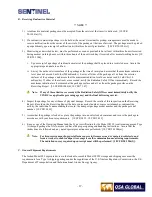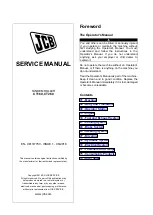
- 22 -
5) Inspect the transport case for damage that could prevent proper assembly prior to shipment or could allow for
package failure during transport (e.g. faulty lid clasps, missing pieces of blocking material inside the package,
perforations or cracks of the case, etc.)
6) Inspect the threaded mounting holes on the main body of the device to ensure dirt or sludge is not lodged in the
threads. Inspect the threads to ensure they are not stripped and will retain the hardware intended for the hole when
tightened.
C.
Daily Inspection of the crank-out remote controls
The remote control consists of a control crank, a control drive cable with a connector swaged at one end, two control
cable conduits and a connector plug assembly.
The control crank contains a diagonally cut, geared drive wheel that matches the outer helical winding of the control
cable. This worm-gear arrangement of the control crank drive wheel and the control cable provides the radiographer
with a reliable means to project and retract the source assembly to and from the exposure device. The control crank is
equipped with a lever brake that retains the source assembly while in the exposure head. Beneath the control crank
handle is a label that indicates the direction for EXPOSE and RETRACT during use in addition to ON and OFF
positions for the brake. Control cranks are available with an odometer to provide the radiographer with the approximate
travel distance of the source assembly. The travel distance is indicated in increments of feet and tenths of a foot.
Radiographers can count the number of rotations of the crank handle when using control cranks that are not equipped
with odometers to obtain an approximation of the travel distance. One full revolution of the standard crank handle is
equal to approximately 10 in (25.4 cm) of travel. One full revolution of the newer extreme control crank is equal to 12 in
(30.5 cm) of travel.
When using remote controls with the Model 989 exposure device, the radiographer will only need to turn the hand crank
approximately ¼ of a full revolution to expose the source into the beam port of device collimator. During the first
radiographic exposure, the radiographer should take notice of the hand crank position relative to the handle when the
source is manipulated to the “exposed” and the “secured” positions.
Two remote control conduits (sheaths, housings) are attached to the control crank. One conduit contains the working
side of the control cable that drives the source assembly out of the exposure device to the fully shielded position into the
device’s internal collimator. The second conduit is the reserve conduit containing the length of the control cable
necessary for projection of the source assembly. The remote control conduits provide a degree of protection of the
control cable against the elements common to the industrial radiography working environments.
Attached to the opposite end of the remote control conduits is a connecting plug assembly that is used for attachment of
the remote controls to the locking mechanism of the exposure device. The connecting plug assembly and the control
cable connector are designed with minimal tolerances. A connection of the source assembly connector to the control
cable connector must be completed before the remote control connecting plug assembly can be attached to the locking
mechanism of the exposure device.
A protective end-cover must be installed after use of the remote controls. The protective cover provides protection to the
connecting plug assembly and the control cable connector, and prevents the ingress of water, mud, sand or other foreign
matter.
IMPORTANT WARNING
The control cable connector is a made from hardened steel and should never be left unprotected or forced into
connection with the source assembly as this could damage the connector over time leading to possible breakage during
use. Always use the protective end-cover when remote controls are not connected to the exposure device and always
manually move the sleeve of the female connector of the source assembly to the OPEN position when connecting and
disconnecting the control cable from the source assembly.
Summary of Contents for 989
Page 1: ...MAN 037 October 2017 ...
















































